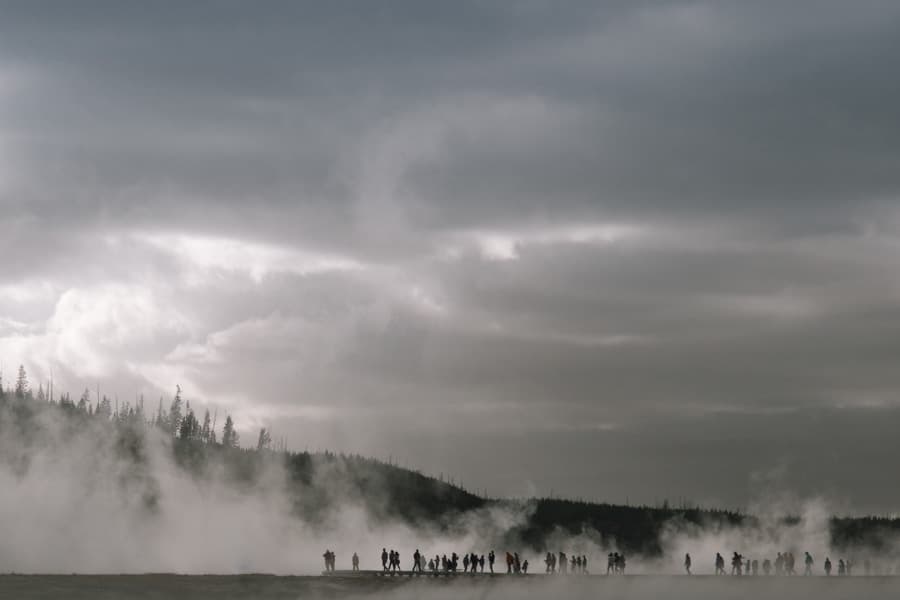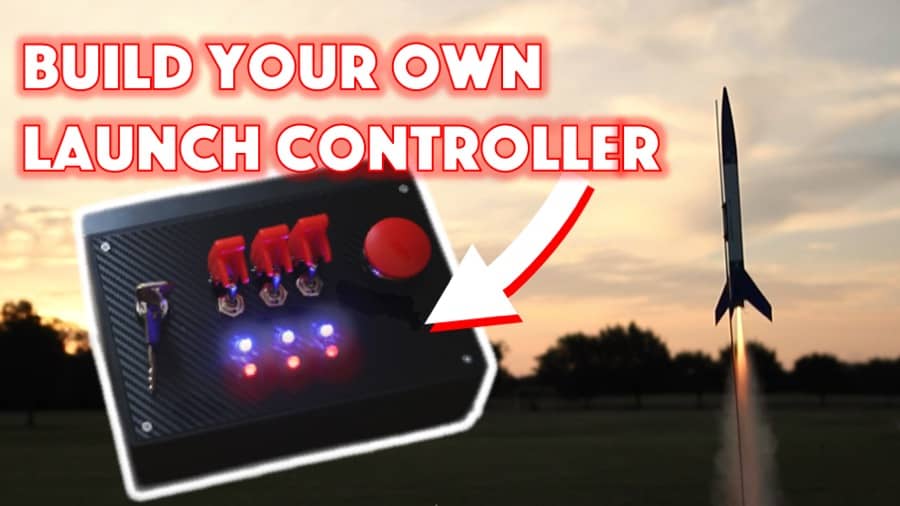
If you live in an area that gets hot, humid summers, then you know what it is like. It can be miserable. If you’re in misery, then you are probably wondering how your model rocket is faring.
So, how does humidity affect model rockets? Humidity can cause the paper tube of your model rocket to swell, a plastic parachute to stick, or glue to set ineffectively, but launching in humidity can help your model rockets reach a higher altitude.
Model rocketry is rocket science. So many different things can influence the flight of a model rocket that it can sometimes it can be mind boggling. Humidity is another one of those things that impacts the model rocket at every phase of its life. Continue reading to find out how humidity can impact your model rocket.
Are you still using the standard Estes controllers for your launches?
We just built our own beautiful launch controllers that make launches SO much more fun, and we documented EVERY single step and item purchased and put it into a step-by-step course that teaches you how to do the exact same thing.
Click here to learn more about how you can build your own launch controllers!

Humidity and Model Rockets
In order to understand how humidity affects model rockets, I’m first going to explain what humidity is, and then I’ll explain how it impacts the building of your model rocket, as well as the launch, retrieval, and storage.
What is Humidity?
Humidity describes the amount of water vapor that is in the air. It is most commonly measured as relative humidity when you’re looking at the local weather report.
Relative humidity describes the amount of humidity in the air compared to how much water vapor the air is capable of holding. How much water vapor the air can hold will increase as the temperature increases.
For example, if the relative humidity is 75%, then the air is holding three quarters of the water vapor it could potentially hold at the temperature it is currently at.
This means that on a hot day with a relative humidity of 75%, the amount of water vapor in the air will be greater than on a cold day with a relative humidity of 75%.
If the relative humidity is 100%, it cannot hold any more water vapor. Evaporation will stop, and condensation may appear.
In high humidity conditions, we feel hotter because the sweat on our skin evaporates at a slower rate. In 100% humidity, our sweat would not evaporate at all. This why people tend to prefer a “dry heat” to humidity.
There are other ways to measure humidity, but relative humidity is the easiest to get information on because it is listed by the weather report.
But how does this all relate to model rockets? Continue reading!
The Problems of Humidity
Humidity causes several problems at different stages of your model rocket’s life, and I will take you through each of these problems one by one.
You won’t experience most of these problems, at least not in a substantial way, when the humidity is at moderate levels of 40%-60% relative humidity.
When You’re Building the Model Rocket
The problems with humidity start right away. Humidity can really get in the way of you building your model rocket efficiently. If you are building on a humid day, you may experience trouble with the following:
- Paint dry times
- Glue dry times
- Tape not sticking
- Blushing in lacquer paint
The most noticeable difference you will experience in humid weather is that glue and paint are going to take a longer time to dry. This can be really frustrating. I don’t know about you, but humid or not, it feels like my glue and paint takes forever to dry as it is, or maybe I am just impatient.
Glue and paints take longer to dry because they rely on evaporation to remove moisture, and in high humidity, the rate of evaporation decreases. You will have to wait longer between coats of paint and leave pieces to dry for longer.
If you use tape when you are building the rocket or the rocket’s engine, you should also note that tape often has trouble sticking when it is excessively humid. Scotch makes a masking tape (link to read reviews on Amazon) that is specific for humid condition, if you need to build or launch in high humidity.
If you use a lacquer paint or finish on your model rocket it can also “blush” in high humidity. A blush creates a foggy looking finished product, and is not at all desirable. Your best bet is to wait for a day with less humidity to paint or switch to enamel paints which will not blush.
When You’re Launching the Model Rocket
There are a couple of difficulties you could face when you launch a model rocket on a humid day. Luckily, these aren’t so difficult to overcome.
Problems you could face at launch include:
- Swelling in the paper parts of the model rocket
- Nose cone not coming off
- Plastic parachutes not opening
The paper parts of a model rocket can swell in high humidity because the paper will soak up moisture from the damp, humid air, and it will expand as it does this. As the paper tube swells, the circumference of the interior will shrink.
In moderate humidity, this swelling won’t make much of a difference, but if the paper tube is exposed to too much humidity, you could have trouble inserting or removing the engine.
You can usually solve any nose cone problems by sanding the nose cone to fit into the tube, but for the engine, you may have to just push it in to place.
On a humid day you will need to check the fit of your nose cone as the swelling of the tube could make the fit too tight. If the fit of the nose cone is too tight, it will not pop off the way it should with the ejection charge. You can sand down the shoulder of the nose cone a little to get it to fit better in the tube.
If the nose cone does come off the way it should, you could still have trouble with a plastic parachute that doesn’t want to open. This happens because the plastic of the parachute tends to stick together in high humidity.
You can solve this problem by sprinkling baby or talc powder on the parachute before folding it. This will prevent any sticking. Some people like to do this as part of their normal routine.
Alternatively, you could use a nylon streamer or a nylon parachute.
When You Store Your Model Rocket
If you live in an area where you get high or drastically fluctuating humidity, you will need to be more careful about how your store your model rockets. Model rockets are typically stored in garages, basements, and attics, but these may not be the best places to keep them.
You should store your model rockets in a cool dry area to prevent them from becoming damaged from the humidity.
Drastically fluctuating humidity is perhaps even worse for model rockets than high humidity as the rocket’s paper and wood parts will absorb moisture and dry repeatedly, a process that could cause substantial damage over time.
You should be doubly careful about how you store your model rocket engines. Tossing them in your garage is not a great idea if you live in an area that gets very humid or freezing weather.
Estes says that as long as the engines are “not exposed to excessive humidity, and temperature cycling [extreme heat or cold (140 degrees to 32 degrees Fahrenheit)] the engines should perform properly” (source).
The danger of excessive humidity is that moisture will get into the engine and the propellant. If enough moisture gets into the propellant, the engine will probably CATO.
This risk is even greater if excessive humidity causes moisture to get into the engine, and then that moisture freezes inside the propellant because of a dip in the temperature. This will cause cracks to form in the propellant as water expands when it turns to ice.
Temperatures below freezing will often cause cracks in black powder propellant even without humidity, but the humidity will exacerbate the situation.
It is best to store your model rocket motors in a location that is dry and that does not experience below freezing temperatures.
The Advantage of Humidity
But, having humid weather isn’t all bad when it comes to model rockets. In fact, if you’re trying to beat a record, personal or otherwise, for altitude, a humid day would be the perfect day to launch.
Many people believe that the air is thicker when the weather is humid, and this is a completely understandable assumption because it certainly feels thicker, but this is not true. The more humid the air is, the less dense it becomes, the higher your model rocket will fly.
The model rocket will fly higher in the less dense air because it will not experience as much drag.
But let’s take a step back. How on earth is humid air less dense than dry air? It goes against everything we experience on a humid day, but it is the truth. Humid air is less dense because water vapor does not weigh as much as the oxygen and nitrogen gases that make up most of the Earth’s atmosphere.
According to the results of simulated model rocket launches in RockSim, a launch that takes place on day with 15% humidity will not go as high as a launch that takes place on a day with 85% humidity. The difference in the high altitude flights (21,000+ feet) was only about 51 feet.
This difference is noticeable at these heights, but if you’re only launching to a couple hundred feet the difference would not be as significant. Even if you are launching to 1,000 feet you may only see a foot or two difference.
The best way to predict how high humidity will affect your model rocket is to use a rocket simulator.
However, it is important to remember the air temperature also has an impact on how high a rocket will fly as well as the elevation of the launch site.
Temperature and Humidity
The warmer the air is, the more water vapor it can hold. When talking about relative humidity, this means a cold day and a warm day could have the same relative humidity, but the actual amount of water vapor in the air, which is called the specific humidity, would be very different.
However, not all warm air carries a lot of moisture in it. Desert areas often experience dry heat, while areas near large water sources often get a lot more humid weather. In these dry environments, evaporation takes place rapidly. Your paint and glue will dry rapidly, and humidity will not gum up the workings of your rocket.
You will likely see enhancements to the performance of your model rocket when the weather is both hot and humid because the amount of moisture in the air will be greater and higher temperatures have also proven to allow a model rocket to fly higher.
When you are selecting a day for a high altitude flight, don’t only focus on humidity. There are other factors that are more important like wind speed, temperature, and the elevation of the launch site. In fact, humidity probably has the least impact on altitude when compared to these other things.
Tips for Dealing with High Humidity
Honestly, the best tip I can give you for dealing with the disadvantages of high humidity is to avoid it, but if you’re going to build or launch on a day with high humidity, then here are some things you can try to help offset some of the drawbacks.
- Use baby powder on any plastic parachutes or swap them out for nylon parachutes.
- Bring sandpaper to the launch to address any issues with the nose cone.
- Bring a wooden dowel to the launch so you can push out any stuck engines or recovery systems.
- Allow the rockets to dry in a climate controlled location.
- Use tape that can hold up in humidity like the Scotch masking tape for humid conditions.
- Avoid lacquer paints. Stick to enamel paints because they will not ghost in humidity.
- Store your engines in above freezing temperatures and out of humidity.
- Store your rockets in a cool dry location.
- Bring some cold drinks on launch day, because humidity can make it feel far hotter than it actually is.
If you do these things, you will probably not run into many of the problems that humidity can cause.
Humidity and Rain
High humidity is necessary for clouds and precipitation. If you live in an area with high humidity, you probably also get a lot of rain.
Launching model rockets in the rain is not the best idea. A lot can go wrong during a rainy day launch, but one of the most pertinent reasons to avoid a rainy day launch is because it is kind of miserable. Trying to watch a model rocket fly through up into the sky with raindrops pelting you in the face isn’t a fun experience.
If you plan to launch in a light rain, make sure you have a dry location to store your equipment and to prepare your model rocket to launch. Bring a raincoat with a hood or an umbrella and extra tarps or plastic covering for any equipment that could get wet.
Also, be prepared to recover your model rocket quickly if it is made with paper tubes. If water gets inside the tube, it could get ruined.
You should never launch in a heavy rain or a storm. You won’t enjoy it, and your launch equipment and rocket could get ruined by water damage.
The Most Humid Locations in the US
If you live near any of these locations, you are more likely to experience problems with humidity. The humidity likely won’t impact your enjoyment of your model rocket as long as you take some of the precautions listed above.
US Cities with the Highest Average Relative Humidity
| US City | Average Relative Humidity |
| New Orleans, Louisiana | 75.9 |
| Jacksonville, Florida | 75.8 |
| Houston, Texas | 74.7 |
| Orlando, Florida | 74.1 |
| Tampa, Florida | 74.1 |
| San Francisco, California | 73.7 |
| Seattle, Washington | 73.3 |
| Miami, Florida | 73.2 |
| Portland, Oregon | 73.2 |
| Rochester, New York | 72.6 |
If you’re interested in finding areas with higher specific humidity, you should check out the map that is located here. It shows that most of the United states has average to higher than average specific humidity, except for the mid-south, which tends to be drier.
The Takeaway
Humidity can cause problems during a model rocket build by increasing the amount of time it takes paint and glue to dry. It can cause problems with your launch if the paper tube swells or the parachute does not open all the way, and it can cause problems with storing both the model rocket itself and its engines.
But humidity has one redeeming quality, which is that it actually allows a model rocket to reach a slightly higher altitude.
However, the difference in altitude is negligible in most cases unless you are launching a high altitude model rocket and going for a record.
Build Your Own Launch Controller
Don’t forget! You can ditch the stock controllers and confidently build your own from scratch using our step-by-step instructions and exact materials list! We promise this will make your launch experience 10x better, and using our course License to Launch you can be 100% confident you’ll be able to finish this project and be super proud of what you’ve built! Here’s a sneak peek below.
